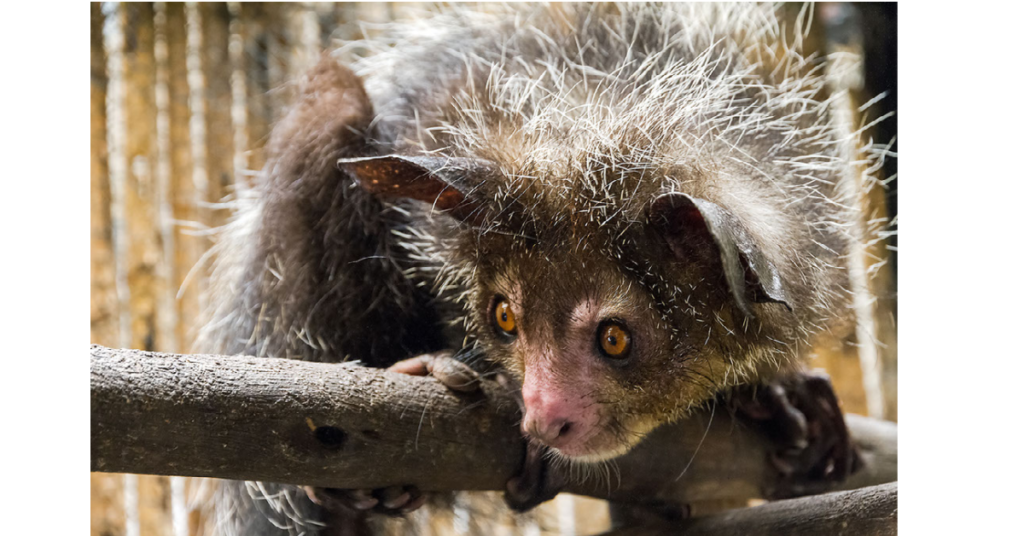Imagine yourself walking through a dense forest canopy in Madagascar, feeling the humidity and the rich scent of exotic plants in the air. Suddenly, you hear a rustling in the trees, and your eyes catch sight of a creature unlike anything you’ve ever seen before. Its appearance is almost otherworldly, with oversized eyes that seem to peer into your soul, bat-like ears that twitch at every sound, and a long, thin, bony finger that looks like it could reach out and touch you. This is the aye-aye.
A creature that defies explanation and challenges our perception of what is possible in the natural world. Despite its strange appearance, the aye-aye is a real animal, and it’s one of the most fascinating and unique creatures on the planet. In this blog, we’ll delve into the mysteries of the aye-aye and discover why this creature is so rare and remarkable!
What is Aye-Aye?
Meet the aye-aye, the primate that looks like it was designed by a committee of mad scientists! These fascinating creatures are a type of lemur that live in Madagascar, and they have some truly unique characteristics that set them apart from other lemurs. Let’s take a closer look!
First off, let’s talk about those eyes. They’re huge, like something out of a cartoon, and give the aye-aye an almost otherworldly appearance. And those ears? They’re enormous too, allowing these lemurs to pick up even the faintest sounds of insects hiding inside trees.
But the real star of the show when it comes to aye-aye anatomy is that crazy middle finger. It’s long, thin, and flexible, making it the perfect tool for probing tree bark and extracting insects. And when I say “extracting,” I mean it – the aye-aye can chew through wood with its razor-sharp teeth and then use its middle finger to fish out its dinner.
So next time you’re in Madagascar (or just browsing YouTube), keep an eye out for the aye-aye. This wacky primate may not be winning any beauty contests, but it’s certainly one of the most fascinating creatures on the planet!
Physical Characteristics
First of all, aye-ayes have big, beautiful eyes that help them see in the dark. That’s because they are primarily active at night, so they need to be able to find their way around in the darkness. Their large ears are also incredibly sensitive, allowing them to detect the sounds of insects moving inside trees – which just so happens to be their favorite food!
Speaking of food, the aye-aye has a very special way of finding its next meal. They use their long, bushy tails to help them balance as they climb through the trees, but they also use their tails to communicate with each other. And when they’re looking for insects to eat, they use their middle finger – which is tiny and bony, with a sharp hook at the tip – to tap on trees and listen for the sounds of insects moving inside.
Once they’ve located an insect, the aye-aye uses its sharp teeth to eat a hole in the bark of the tree. Then, using that trusty middle finger, the aye-aye extracts the bug from the tree and enjoys a tasty snack.
Behavior
Did you know that aye-ayes are like the Batman of the animal kingdom? These unique creatures are primarily nocturnal, which means they only come out at night. During the day, they sleep in cozy nests made from leaves and branches.
Aye-ayes are known for their solitary nature, and they only come together during mating season. They are quite territorial and mark their territories with urine and scent glands. But what makes aye-ayes even more fascinating are their unique vocalizations. They communicate with grunts, clicks, and squeaks.

Diet
The aye-ayes are expert insectivores. They have a keen sense of smell and can detect the presence of insects hiding inside trees. Using their sharp teeth, they gnaw holes in the bark to create a pathway to their prey. It’s a bit like playing a game of hide-and-seek, but with aye-ayes always coming out on top! And although insects make up the majority of their diet, aye-ayes also enjoy the occasional fruit or seed. They have a particular liking for the fruit of the ramy tree, which is abundant in their native habitat. They are expert hunters and scavengers, with a keen eye for the tiniest insects and the skills to extract them from even the smallest crevices.
Conservation Status
Did you know that the aye-aye is facing a critical threat of extinction? Sadly, despite their remarkable physical adaptations, aye-ayes are facing a serious threat to their survival. Due to habitat loss and hunting, these lemurs are now considered critically endangered. This means that, without intervention, we could lose one of the most unique and fascinating species on the planet. Despite being one of the rarest primates in the world, aye-ayes have fascinating features that make them stand out. However, the aye-aye’s unique features have made them a target for hunters, who prize their meat and fur.

Furthermore, deforestation has reduced the aye-aye’s natural habitat, causing their numbers to dwindle. But, conservation efforts have been put in place to help save these precious creatures from extinction. To protect the aye-aye, national parks and reserves have been established, providing safe spaces for them to thrive. Additionally, education programs have been implemented to teach local communities about the importance of preserving the aye-aye and its habitat. These efforts have already started to show promising results, with the aye-aye population slowly growing.
The Aye-Aye: A Marvel of Nature, Threatened by Habitat Loss and Hunting
As we wrap up our discussion on the aye-aye, let me leave you with a thought: imagine having the power to see through walls, hear the slightest sounds from a distance, and even use your elongated middle finger to fish out insects from inside tree bark. Sounds impossible, right? But this is exactly what the aye-aye can do, making it a true marvel of nature. It’s the largest nocturnal primate in the world, spending most of its days sleeping in tree hollows and venturing out at night to search for food. Sadly, the aye-aye’s distinctive features also make it a target for hunters and habitat loss. It’s heart-wrenching to think that we might lose such a unique and valuable part of Madagascar’s ecosystem forever. By supporting conservation efforts, we can help ensure that future generations will have the chance to marvel at this incredible creature and all the other unique species that call Madagascar home. So let’s work together to keep the aye-aye swinging through the treetops for years to come!
If you want to gain further knowledge about it, you can purchase the recommended book

1 Comment